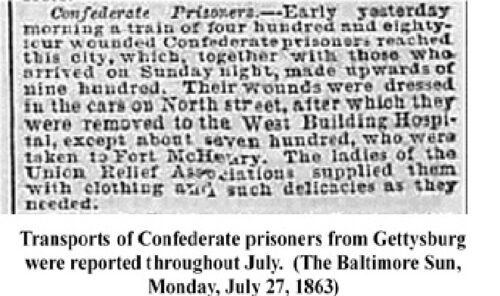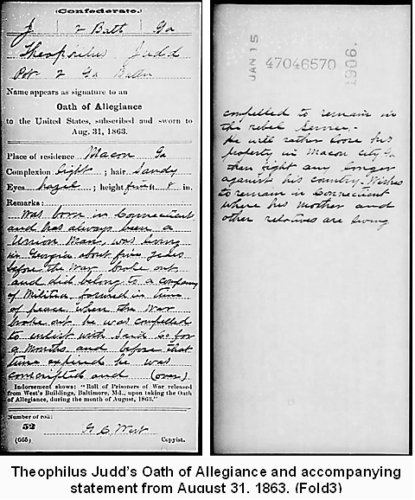A Connecticut Confederate at Gettysburg
By Carolyn Ivanoff
After the Battle of Gettysburg wounded Confederate prisoners were transported and detained in West U.S. Hospital in Baltimore, Maryland. On August 31, 1863, one of these prisoners swore the Oath of Allegiance to the United States of America and was released, free to return to his home in Bridgeport, Fairfield County, Connecticut.
Corporal Theophilus Judd was wounded fighting for the Confederacy with his southern comrades in the 2nd Georgia Battalion of Wright’s Brigade On July 2, 1863. The battalion had 78 casualties out of the 173 men engaged, Major George Ross was mortally wounded, Captain George S. Jones was wounded (Civil War in the East), and Theophilus Judd, became one of those wounded, suffering a gunshot wound in the right shoulder. (CMSR-Fold3) Judd was captured and taken to the Federal Eleventh Corps Hospital at the George Spangler Farm. His name was found on the roster of wounded Confederates by Wayne Motts, President, and CEO of the Gettysburg Foundation, while researching the Spangler Farm Hospital. No one had previously looked closely at the stories of the Confederate wounded at this hospital. What is so intriguing about Judd was that this wounded Confederate prisoner fighting for the Confederacy was from Fairfield County, Connecticut. Ironically, other Fairfield County Connecticut men wounded fighting for the Union were also taken to this hospital at the George Spangler Farm. Though Confederate wounded were technically kept separated from the wounded Union men, it is intriguing to speculate whether Theophilus Judd was recognized by men from his hometown and county in the pandemonium and chaos of the hospital during and after the battle.

Dr. Robert Hubbard, Surgeon of the 17th Connecticut and medical inspector of the Eleventh Corps, was in charge of evacuating the wounded men at the George Spangler Farm out of Gettysburg by rail to hospitals all over the east coast. Hubbard was a prominent physician in Bridgeport, Connecticut before and after the war and knew many of the families in Fairfield County. With a name like Theophilus Judd on a short list of wounded Confederate prisoners at Spangler farm it’s interesting to speculate whether the good doctor recognized his name.
Judd was transported to Baltimore by rail on July 21, 1863, and admitted to Ward H, USA General Hospital West’s Building Baltimore, MD along with other wounded Confederate prisoners. Ten days later on August 31, 1863, his carded medical record from West Hospital stated that Theophilus Judd, Company C, 2nd Georgia Battalion, swore the oath of allegiance to the United States. The card describes Judd’s complexion as light, his hair sandy, his eyes hazel, and his height 5 foot 8 inches. The remarks section on the card detailed that Judd, “Was born in Connecticut and has always been a Union man. Was living in Georgia about five years before the war broke out and did belong to a company of militia in time of peace. When the war broke out he was compelled to enlist with said company for nine months and before that time expired he was conscripted and compelled to remain in the rebel service. He will rather loose his property in Macon City Georgia than fight any longer against his country. Wishes to remain in Connecticut where his mother and other relatives are living.” On September 1, 1863, having sworn the oath of allegiance to the United States of America, Theophilus Judd’s service to the Confederacy was over. He was released and made his way home to Bridgeport, Connecticut.
How does a Connecticut Yankee wind up in Macon, Bibb County, Georgia in 1861 fighting for the Confederacy? We may never know. The statement Judd gave upon his oath may offer some plausible explanation, however, some of his claims seem suspicious when compared with existing records. There is no doubt that Theophilus Judd was born in Fairfield County, Connecticut. His father was Lewis M. Judd, a cooper, and his mother was Maria Todd Judd. In the 1850 census, Theophilus was listed as 12 years old, living with his mother’s brother, his uncle and aunt, in Stratford, Connecticut and attending school.
In the statement Judd gave when he swore his oath of allegiance, he claimed he had been living in Georgia about five years before the war broke out. However, the 1860 census for New Haven, Connecticut lists him as living in a boarding house in that city and working as a carpenter/stair maker, an occupation he would practice throughout his life. No record of anyone named Judd could be located in the Macon, Bibb County property records or census for 1860.
Without a doubt, on May 17, 1861, Judd enlisted with other men from Macon, Bibb County, Georgia in Company C, known as the Floyd Rifles, 2nd Battalion, Georgia Volunteer Infantry. The Floyd Rifles were a militia group in Bibb County. In the antebellum era young men, north and south, readily joined militia groups with their friends and neighbors. These groups served as social and community associations. After Fort Sumpter, these militia organizations supplied the first volunteers for military service. Except for a period from August 10 to October 20, 1862, when he was hospitalized at Petersburg for febrile typhoid, Theophilus Judd was present for duty from the time of his enlistment in May 1861 until he was wounded at Gettysburg on July 2, 1863. He must have done his duty well because his Compiled Military Service Record from the Confederate Army lists him as receiving a promotion to corporal in January 1862. (Fold3) From the records it appears he did his duty and campaigned with Company C, 2nd Georgia Battalion until he was wounded and captured at Gettysburg. Despite Judd’s claim that, “he was conscripted and compelled to remain in the rebel service.” There is no indication he was coerced in any way as a rebel soldier, except the probability that his one year volunteer enlistment (or nine months as he stated) was altered to continue for the duration of the war.
Rifles were a militia group in Bibb County. In the antebellum era young men, north and south, readily joined militia groups with their friends and neighbors. These groups served as social and community associations. After Fort Sumpter, these militia organizations supplied the first volunteers for military service. Except for a period from August 10 to October 20, 1862, when he was hospitalized at Petersburg for febrile typhoid, Theophilus Judd was present for duty from the time of his enlistment in May 1861 until he was wounded at Gettysburg on July 2, 1863. He must have done his duty well because his Compiled Military Service Record from the Confederate Army lists him as receiving a promotion to corporal in January 1862. (Fold3) From the records it appears he did his duty and campaigned with Company C, 2nd Georgia Battalion until he was wounded and captured at Gettysburg. Despite Judd’s claim that, “he was conscripted and compelled to remain in the rebel service.” There is no indication he was coerced in any way as a rebel soldier, except the probability that his one year volunteer enlistment (or nine months as he stated) was altered to continue for the duration of the war.
Judd’s claim that “he will rather lose his property in Macon City Georgia than fight any longer against his country.” cannot be verified through existing census and property records. If he did own property in Georgia before the war, he probably never owned property again after his return to Connecticut. He was back in Connecticut for less than a year before Theophilus and Addie Hurd married in Bridgeport on August 3, 1864. During his marriage, and after his wife’s death in 1871, census records and city directories list his address as changing almost every year, from rents to boarding houses until his death.
The Bridgeport Evening Farmer reported that Theophilus Judd died at Bridgeport Hospital on May 11, 1910, after a long illness. He never remarried after his wife passed in 1871. He was survived by their four daughters and lived with his youngest, Lena Judd Newcomb, and her husband, in his last years. His obituary listed him as a stair builder by trade and noted that he was well known throughout the city. How well known was he? Was it common knowledge he had fought for the Confederacy at Gettysburg? His Confederate service certainly did not alienate him from his family. His older sister named her first son, born in 1862, for her brother while he was in the Confederate army. When his mother passed away in 1899 at 101, the oldest resident of Fairfield County, articles about her were printed in many of the local papers and all of them acknowledged her three living children, including Theophilus Judd. Of course, none of the articles mentioned he had been a Confederate soldier. But was his service kept secret or was it well known? Of course, most of his male contemporaries were Union veterans. The 17th Connecticut, the Fairfield County Regiment, had fought at Gettysburg and many of the men and families were well known to Judd, and his family, as he was to them.
On May 13, 1910, two days after his death, Theophilus Judd, was interred next to his wife with her family in their plot at Lakeview Cemetery in Bridgeport, Connecticut. The plot was a crowded one when he was interred with eight family members resting there. The marker was an imposing obelisk with his in-laws’ Isaac and Cornelia Hurd’s inscriptions on the front. Addie Hurd Judd, Theophilus’s wife’s inscription was on the left side of the stone. When Wayne Motts told me about this Connecticut Confederate and he told me that Judd was interred in Lawn Cemetery, I thought I knew where to find him. I went to the cemetery on a beautiful, sunny, early September day and wandered. Two workers spotted me and asked if I needed help. I explained I was looking for a large obelisk on Avenue C, Lot 34. They told me that it had toppled down in a storm and took me to it. Addie’s inscription on the base was faded but readable, Addie Hurd, Wife of Theophilus Judd, Died April 26, 1871, Age 26. The huge granite obelisk top had collapsed onto other markers on the right. The other stones in the plot were not really in any order but through the lichen and grime I spotted one marked 17th Connecticut. The cemetery workers were amazed I could read it. They offered to clean the marker and bring me the cemetery plot card. As the stone was sprayed and the worn inscription became more visible, it read: Civil War, George Hurd, Co. G, 17th C.V.I. Theophilus Judd, Company C, 2nd Gorgia Battalion, and George Hurd were brothers-in-law. Both served at Gettysburg, on opposing sides. Connecticut Yankee and Connecticut Rebel. Perhaps this is the story of the Civil War, brother against brother. Now together forever, both men are interred in the same family cemetery plot along with a third brother-in-law, Benjamin Watrous, Company D, 29th Michigan. A fourth brother-in-law, Edwin A. Hurd, interred elsewhere, also served in the 17th Connecticut as a commissary sergeant, and a fifth brother-in-law, William Henry Boughton, served in Company I, 6th Connecticut. May peace be with all of them.

I would like to thank Wayne Motts, CEO and President of the Gettysburg Foundation, for identifying Theophilus Judd, a Connecticut Confederate, and for motivating me to write this Grass Roots History article for the Bridgeport History Center. As always, the stories of people from Bridgeport and Connecticut intrigue and fascinate me. The Civil War has many lessons for us as 21st century Americans. The past speaks to us with many voices. May we pay attention and remember and learn. – Carolyn Ivanoff, author, We Fought at Gettysburg.
Selected Bibliography:
Bridgeport History Center newspapers on microfilm
Bridgeport City Directories
Census Records
Find-A-Grave.com
Fold3.com
Ancestry.com
Interment Records, Lakeview Cemetery, Bridgeport, Connecticut
